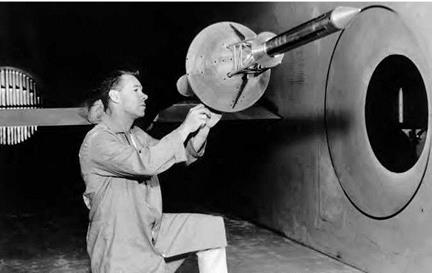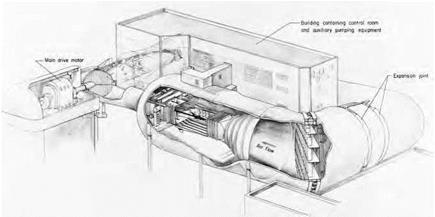The Unitary Plan Tunnels
In the aftermath of World War II and the early days of the Cold War, the Air Force, Army, Navy, and the NACA evaluated what the aeronautical
industry needed to continue leadership and innovation in aircraft and missile development. Specifically, the United States needed more transonic and supersonic tunnels. The joint evaluation resulted in proposal called the Unitary Plan. President Harry S. Truman’s Air Policy Commission urged the passage of the Unitary Plan in January 1948. The draft plan, distributed to the press at the White House, proposed the installation of the 16 wind tunnels "as quickly as possible,” with the remainder to quickly follow.[551]
Congress passed the Unitary Wind Tunnel Plan Act, and President Truman signed it October 27, 1949. The act authorized the construction of a group of wind tunnels at U. S. Air Force and NACA installations for the testing of supersonic aircraft and missiles and for the high-speed and high-altitude evaluation of engines. The wind tunnel system was to benefit industry, the military, and other Government agencies.[552]
The portion of the Unitary Plan assigned to the U. S. Air Force led to the creation of the Arnold Engineering Development Center (AEDC) at Tullahoma, TN. Dedicated in June 1951, the AEDC took advantage of abundant hydroelectric power provided by the nearby Tennessee Valley Authority. The Air Force erected facilities, such as the Propulsion Wind Tunnel and two individual 16-Foot wind tunnels that covered the range of Mach 0.2 to Mach 4.75, for the evaluation of full-scale jet and rocket engines in simulated aircraft and missile applications. Starting with 2 wind tunnels and an engine test facility, the research equipment at the AEDC expanded to 58 aerodynamic and propulsion wind tunnels.[553] The Aeropropulsion Systems Test Facility, operational in 1985, was the finishing touch, which made the AEDC, in the words of one observer, "the world’s most complete aerospace ground test complex.”[554]
The sole focus of the AEDC on military aeronautics led the NACA to focus on commercial aeronautics. The Unitary Plan provided two benefits for the NACA. First, it upgraded and repowered the NACA’s existing wind tunnel facilities. Second, and more importantly, the Unitary
Plan and provided for three new tunnels at each of the three NACA laboratories at the cost of $75 million. Overall, those three tunnels represented, to one observer, "a landmark in wind tunnel design by any criterion—size, cost, performance, or complexity.”[555]
The NACA provided a manual for users of the Unitary Plan Wind Tunnel system in 1956, after the facilities became operational. The document allowed aircraft manufacturers, the military, and other Government agencies to plan development testing. Two general classes of work could be conducted in the Unitary Plan wind tunnels: company or Government projects. Industrial clients were responsible for renting the facility, which amounted to between $25,000 and $35,000 per week (approximately $190,000 to $265,000 in modern currency), depending on the tunnel, the utility costs required to power the facility, and the labor, materials, and overhead related to the creation of the basic test report. The test report consisted of plotted curves, tabulated data, and a description of the methods and procedures that allowed the company to properly interpret the data. The NACA kept the original report in a secure file for 2 years to protect the interests of the company. There were no fees for work initiated by Government agencies.[556]
The Langley Unitary Plan Wind Tunnel began operations in 1955. NACA researcher Herbert Wilson led a design team that created a closed – circuit, continual flow, variable density supersonic tunnel with two test sections. The test sections, each measuring 4 by 4 feet and 7 feet long, covered the range between low Mach (1.5 to 2.9) and high Mach (2.3 to 4.6). Tests in the Langley Unitary Plan Tunnel included force and moment, surface pressure measurements and distribution, visualization of on – and off-surface airflow patterns, and heat transfer. The tunnel operated at 150 °F, with the capability of generating 300-400 °F in short bursts for heat transfer studies. Built at an initial cost of $15.4 million, the Langley facility was the cheapest of the three NACA Unitary Plan wind tunnels.[557]
The original intention of the Langley Unitary Plan tunnel was missile development. A long series of missile tests addressed high-speed
|
A model of the Apollo Launch Escape System in the Unitary Wind Tunnel at NASA Ames. NASA. |
performance, stability and control, maneuverability, jet-exhaust effects, and other factors. NACA researchers quickly placed models of the McDonnell-Douglas F-4 Phantom II in the tunnel in 1956, and soon after, various models of the North American X-15, the General Dynamics F-111 Aardvark, proposed supersonic transport configurations, and spacecraft appeared in the tunnel.[558]
The Ames Unitary Plan Wind Tunnel opened in 1956. It featured three test sections: an 11- by 11-foot transonic section (Mach 0.3 to 1.5) and two supersonic sections that measured 9 by 7 feet (Mach 1.5 to 2.6) and 8 by 7 feet (Mach 2.5 to 3.5). Tunnel personnel could adjust the airflow to simulate flying conditions at various altitudes in each section.[559]
The power and magnitude of the tunnel facility called for unprecedented design and construction. The 11-stage axial-flow compressor featured a 20-foot diameter and was capable of moving air at 3.2 million cubic feet per minute. The complete assembly, which included over
2,0 rotor and stator blades, weighed 445 tons. The flow diversion valve allowed the compressor to drive either the 9- by 7-foot or 8- by 7-foot
supersonic wind tunnels. At 24 feet in diameter, the compressor was the largest of its kind in the world in 1956 but took only 3.5 minutes to switch between the two wind tunnels. Four main drive rotors, weighing 150 tons each, powered the facility. They could generate 180,000 horsepower on a continual basis and 216,000 horsepower at 1-hour intervals. Crews used
10,0 cubic yards of concrete for the foundation and 7,500 tons of steel plate for the major structural components. Workers expended 100 tons of welding rods during construction. When the facility began operations in 1956, the project had cost the NACA $35 million.[560]
The personnel of the Ames Unitary Plan Wind Tunnel evaluated every major craft in the American aerospace industry from the late 1950s to the late 20th century. In aeronautics, models of nearly every commercial transport and military fighter underwent testing. For the space program, the Unitary Plan Wind Tunnel was crucial to the design of the landmark Mercury, Gemini, and Apollo spacecraft, and the Space Shuttle. That record led NASA to assert that the facility was a "unique national asset of vital importance to the nation’s defense and its competitive position in the world aerospace market.” It also reflected the fact that the Unitary Plan facility was NASA’s most heavily used wind tunnel, with over 1,000 test programs conducted during 60,000 hours of operation by 1994.[561]
|
SAMPLE AEROSPACE VEHICLES EVALUATED IN THE UNITARY PLAN WIND TUNNEL |
||
|
MILITARY |
COMMERCIAL |
SPACE |
|
Convair B-58 |
McDonnell-Douglas DC-8 |
Mercury spacecraft |
|
Lockheed A-1 2/YF-1 2/SR-71 |
McDonnell-Douglas DC-10 |
Gemini spacecraft |
|
Lockheed F-104 |
Boeing 727 |
Apollo Command Module |
|
North American XB-70 |
Boeing 767 |
Space Shuttle orbiter |
|
Rockwell International B-1 |
||
|
General Dynamics F-1 1 1 |
||
|
McDonnell-Douglas F/A-18 |
||
|
Northrop/McDonnell-Douglas YF-23 |
The National Park Service designated the Ames Unitary Plan Wind Tunnel Facility a national historic landmark in 1985. The Unitary Plan Wind Tunnel represented "the logical crossover point from NACA to NASA” and "contributed equally to both the development of advanced American aircraft and manned spacecraft.”[562]
The Unitary Plan facility at Lewis Research Center allowed the observation and development of full-scale jet and rocket engines in a 10- by 10-foot supersonic wind tunnel that cost $24.6 million. Designed by Abe Silverstein and Eugene Wasliewski, the test section featured a flexible wall made up of 10-foot-wide polished stainless steel plates, almost 1.5 inches thick and 76 feet long. Hydraulic jacks changed the shape of the plates to simulate nozzle shapes covering the range of Mach 2 to Mach 3.5. Silverstein and Wasliewski also incorporated both open and closed operation. For propulsion tests, air entered the tunnel and exited on the other side of the test section continually. In the aerodynamic mode, the same air circulated repeatedly to maintain a higher atmospheric pressure, desired temperature, or moisture content. The Lewis Unitary Plan Wind Tunnel contributed to the development of the General Electric F110 and Pratt & Whitney TF30 jet engines intended for the Grumman F-14 Tomcat and the liquid-fueled rocket engines destined for the Space Shuttle.[563]
Many NACA tunnels found long-term use with NASA. After NASA made modifications in the 1950s, the 20-Foot VST allowed the study of spacecraft and recovery devices in vertical descent. In the early 21st century, researchers used the 20-Foot VST to test the free-fall and dynamic stability characteristics of spacecraft models. It remains one of only two operation spin tunnels in the world.[564]
|
The 8-Foot Transonic Pressure Tunnel (TPT). NASA. |












